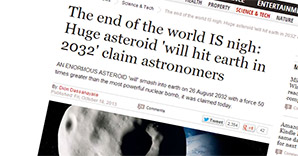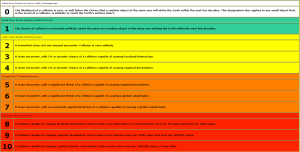Post-Chelyabinsk, media reports of a possible impact with 2013 TV135 still fail to address the issues.

The story starts a few days ago when an observatory in the Ukraine discovered an asteroid that had just passed the Earth at a distance of six and half million miles. A routine discovery that was confirmed by groups in Spain, UK and Buryatia – it’s orbit was calculated and the word got out that there’s a 1 in 65,000 chance that it will impact the earth in 2032. What happens is that, with more observations, over time, the orbit’s calculation is refined until it can be said that, for sure, the rock will miss.They just got a glance of it so far – they’ll have their next look early next year.
A few years ago, a story like this would have produced endless articles and reports on TV as well as the internet about the coming apocalypse at the hands of a killer-asteroid. It would have been hyped, sensationalized and misquoted all over the media.
There was the case of 1997 XF11 – a big old earth- and mars- crosser – that was first found with a slight chance of impacting the earth in 2028. This risk was quickly eliminated once they had re-discovered some old observations but the story had already hit the headlines fueled by the fact that this baby was 2km wide and big enough to some serious damage.

The scientists got all flustered by this tabloid-style reporting and the Torino Scale was born – a mechanism by which the scientists can classify the risk of impact in a way that doesn’t unduly alarm non-scientists. It’s like the Richter Scale for the apocalypse or that clock tat they used to have counting down the minutes to nuclear armageddon. It came at just the right time as more and more asteroids were beginning to be found – many of which featured briefly at Torino Scale 1 before having their risk reduced to zero. Telescopes were being unpacked, national space agencies wee coordinating and Hollywood was fantasizing – it was a busy time; the Torino Scale brought cool order to the misconceptions, panic and confusion.
You see, this is the problem. And it’s something you see all over the place wherever the world of science touches the hyped-up communication frenzies that we call the public media. For the astronomers, it is simple. There’s a bunch of rocks flying round in space and they all have regular orbits around the sun. Or they would have but for the fact that they affect each other’s orbit as they whizz around which means that for little asteroids their orbit is a little hard to work out. For the big guys, the planets, not much affects their orbit except for the sun, of course. Working out the orbit means extrapolating the data into the future and how well you can do that depends on the amount of data you have. So when you first find an asteroid (from, say, a few hundred photographs that were taken over a few days), you can’t say much about the orbit. If it’s big enough – and if there’s any kind of chance that it will hit earth – then it goes in at number one on the Torino Scale. For the scientists, this attribution of probability attached to an event is entirely normal. For non-scientists, it is difficult to grasp – will there be an impact? will there not be an impact? The uncertainty is a vacuum suddenly filled with speculation, panic and idle chatter – a symptom, it seemed, of modern mass communications and the print and web medias. So the Torino Scale was invented as a way for scientists to present the issue to the public. Some newly discovered rock with a suspect orbit would go in at number one, as if to say, look, this rock is nothing to be extra worried about but we’re gonna keep an eye on it.
But then in 2003, there came another situation with the discovery of 2003 QQ47 which was found to have a very small chance of impact next March. Again, this was a mother and big enough to cause threaten civilization if there was any impact. The media hype took off around the world, taking by surprise the astronomers who had to deny that the world was going to end when they knew that there was a small possibility – as in any dynamic system that is an n-body problem – and getting into all kinds of metaphysical knots. They put together a concerted effort spearheaded around NASA’s observatories to explain the how the risk of impact reduces when you get more observations. The media didn’t buy it though; even the BBC characterized their attempt as “playing down the chances of a newly discovered asteroid hitting Earth in 2014.“ Playing down? They’re not playing down anything – they are trying to explain to the unenlightened the reality of the situation.
Because so many new asteroids were being discovered through the well coordinated observations made around the world, and so many of them were earth-crossers, more and more of them would be showing up on the Torino Scale at number one. The astronomers felt they had to do something. The original wording of number one on the Torino scale went like this:
| The chance of collision is extremely unlikely, about the same as a random object of the same size striking the Earth within the next few decades. |
So the scientists tweaked the message in an effort to calm the situation down and explicitly spell it out:
| A routine discovery in which a pass near Earth is predicted that poses no unusual level of danger. Current calculations show the chance of collision is extremely unlikely with no cause for public attention or public concern. |
This is now, with the 2013 TV135 being put at number one on the scale, how many of the newspapers have reported it, quoting the “no cause for public attention” bit, seemingly without irony. In that sense, the Torino Scale Shuffle Trick worked. As I came across the developing story, in fact, all the reporting was very reserved and sober, the only drama was that NASA had to publish a reality check to quash the sensationalists reports. What sensationalist reports? I couldn’t find any – I delved further, looking in the comments and forums. People kept saying there was nothing to worry about and it was a shame about the alarmist reports. What alarmist reports? Eventually it turns out the good old Daily Mail, Express and Mirror plus some tweet from the Russian vice-premier were all responsible for hyping the media response. Ah right, is that it? Must have missed those ones: Instead, genuine newspaper after newspaper after science magazines and websites, that I came across, all were pretty cool, calm and collected and the story was even in danger of evolving into the more important questions like how much resource we should put into looking for killer rocks. But not quite.
Post-Chernobyl reality check?
But from the hundreds of pages, conspicuous by its absence, there was hardly a mention of the Chelyabinsk event from less than a year before – with all those beautiful videos the Russians took from their cars. This kind of got me because I had been developing a hypothesis that a few little impact events would put the detection of these rocks higher up the political agenda and in the minds of the public. It certainly seemed that that was happening, judging by the sober reporting, the release of NASA reality checks – even a snooze-ville reaction, – to me, it seemed like, “yeah, we know, now, these things can happen, we saw it in February – this could be another one but probably isn’t.” But not much mention of that event in February – and the evolution of the public mind stopped right there.
Is this what it will take then to go a step further? Would another actual event like the one over Chelyabinsk focus the discussion a step more? Something smaller (don’t want to get too paranoid), maybe, but something slightly more on target, an impact in a coastal area – somewhere tropical that shows up good on TV.
It’s a difficult proposition to test, however – even if things happen this way. We can be pretty sure that asteroids will again make the news more and more frequently – if only because our better detection rate is producing more candidates for possible impact. As we hunt down smaller rocks of a few hundred meters diameter and less, the population increases too, there are more of them, more names to momentarily occupy number one of the Torino Scale and trigger the journalists’ alert. And we’ll record more and more impacts as more and more humans spread around the globe with cameras connected to a world wide web. There’s going to be plenty of opportunity to further the media discussion.
